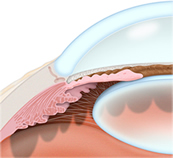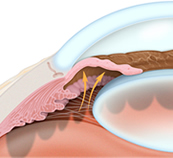Mysthenia Gravis
Myasthenia gravis (MG) is either an autoimmune or congenital neuromuscular disease that leads to fluctuating muscle weakness and fatigue. The name myasthenia gravis, which is Latin and Greek in origin, literally means "grave muscle weakness." Myasthenia Gravis affects persons from all ethnic groups and both genders, although it commonly affects young adult women under the age of forty years, and men over the age of sixty. Myasthenia Gravis can affect persons of any age as well. On occasion, the disease can occur in members of the same family, although the disease is not contagious or directly inherited
Definition
- Chronic auto-immune disorder of the post-synaptic membrane at the neuromuscular junction (NMJ) in skeletal muscle
- Circulating antibodies against the nicotinic acetylcholine receptor (AchR) and associated proteins impair neuromuscular transmission
- Patients present with muscle weakness which typically worsens with continued activity (fatigue) and improves on rest
- Severity varies from isolated eye muscle weakness to generalised muscle weakness and respiratory failure requiring mechanical ventilation
Risk Factors
- Female gender
- Ages 20 – 40
- Familial myasthenia gravis
- D-penicillamine ingestion (drug-induced myasthenia)
- Having other autoimmune diseases
Differential diagnosis
- Lambert-Eaton myasthenic syndrome (LEMS)
- Prominent proximal leg and arm weakness accompanied by diminished muscle stretch reflexes that improve with brief exercise.
- Autonomic symptoms such as dry mouth, constipation and impotence are present in some patients.
- Eye muscles are occasionally involved at presentation.
- Respiratory failure is uncommon.
- Associated with small-cell lung cancer in up to 70% of patients.
- Botulism
- Symptoms similar to myasthenia gravis (MG) but there may be hypotension, bradycardia, diarrhoea followed by constipation, and urinary retention.
- Penicillamine-induced myasthenia gravis
- Symptoms similar to MG can occur after weeks or months of treatment
- They may remit on withdrawal of the drug; recovery may be slow or incomplete
- Primary myopathies
- Gradually progressive muscle weakness which is not fatigable.
- These include auto-immune inflammatory myopathies or heritable myopathies as in mitochondrial diseases, such as progressive external ophthalmoplegia, or oculopharyngeal muscular dystrophy (OPMD).
- Positive family history
- Muscle fatigability
- The weakness worsens with activity (fatigue) and improves on rest and the fluctuations show diurnal variation (better in morning than in the evening)
- Ptosis
- Drooping eyelids and double vision occur early in the majority of patients.
- The pupils are spared.
- Cooling of eyelid for at least 2 minutes with an ice pack (ice test) improves ptosis in more than 95% of patients with myasthenia gravis (MG).
- It does not improve severe ptosis
- Diplopia
- Double vision occurs early in the majority of patients.
- Dysphagia
- Difficulties in chewing or swallowing occur when the facial and oropharyngeal muscles are affected
- Dysarthria
- Changes in speech occur when the oropharyngeal muscles are affected and there may be a characteristic nasal speech
- Facial paresis
- Changes in expression occur when the facial muscles are affected and there may be a characteristic flattened smile
- Proximal limb weakness
- Difficulty in getting out of chairs or climbing stairs.
- There is no evident muscle wasting.
- Reflexes are normal.
- Sensations are intact
- Shortness of breath
- If shortness of breath becomes severe enough to require mechanical ventilation, the patient is said to be in MG crisis
- In myasthenia gravis (MG), an auto-immune attack against acetylcholine receptors (AchRs) results in destruction of the post-synaptic membrane.
- The reduced number of available binding sites for acetylcholine leads to inconsistent generation of muscle fibre action potentials which manifest as skeletal muscle weakness.
- Muscle tyrosine kinase (MuSK) is an agrin dependent protein on muscle membrane with an essential role in anchoring AchR at the tips of the postsynaptic folds
- Serum anti-acetylcholine receptor (anti-AchR) antibody analysis
- Antibodies are detectable in 80% to 90% of patients with generalised myasthenia gravis (MG) and up to 50% of patients with ocular MG.
- Sensitivity: greater than 90% in generalised MG; 40% to 60% in ocular MG.
- Specificity: 99%.
- If the result is negative or equivocal proceed to antimuscle tyrosine kinase (MuSK) antibody assay
- Antimuscle tyrosine kinase (MuSK) antibodies
- Positive test in up to 70% of AchR seronegative generalised MG.
- Serial pulmonary function tests
- Indicated if shortness of breath and suspected MG crisis.
- Serial measurements of FVC and negative inspiratory force (NIF) are taken.
- Indication for mechanical ventilation includes FVC 15 mL/kg or less (normal ≥60 mL/kg) and NIF 20 cm H2O or less (normal ≥70 cm H2O).
- Physicians should not wait for abnormal ABG as it occurs late in the course after clinical decompensation
- Antistriational antibodies
- This test is not done routinely in all patients
- These antibodies are rare in patients without thymoma.
- Detected in 75% to 95% of patients with thymoma and MG
- Repetitive nerve stimulation
- Sensitivity, 79% in generalised MG, 50% in ocular MG.
- Specificity, 97%.
- Brief exercise of a muscle prior to the test may enhance decrement response.
- If the result is negative and clinical suspicion is high, proceed to single fibre EMG.
- Positive decrement also seen in Lambert-Eaton myasthenic syndrome (LEMS) and amyotrophic lateral sclerosis (ALS).
- In MuSK MG, generally the yield of abnormal result is high in proximal muscles, for example the trapezius, deltoid and facial muscles.
- For patients with neck and respiratory weakness, it is important to evaluate clinically affected muscles as the test may be normal in limb and face muscles.
- Greater than 10% decline in compound muscle action potential (CMAP) amplitude between the first and fourth potential in a train of 10 stimulations of the motor nerve at 2 to 3 Hz is considered a positive response
- Single-fibre EMG
- Sensitivity, 86% to 92% and specificity, 70% to 96% in facial muscles in ocular MG;
- Sensitivity and specificity, 98% in generalised MG.
- Abnormal test may be seen in LEMS and ALS, inflammatory myopathies, or patients injected with botulinum toxin.
- Increase variability in motor latencies (jitter) or complete failure of neuromuscular transmission (block) in some muscle fibres
- CT of chest
- Should be performed in all newly diagnosed patients to detect thymoma (which occurs in about 15% of patients with MG) or thymic hyperplasia (which occurs in 75% of MG patients)
a) conservative
- Supportive care
- Includes DVT prophylaxis; ulcer prophylaxis; adequate nutrition and hydration; and avoidance of infections and drugs that may worsen myasthenia symptoms.
- Plasma exchange or intravenous immunoglobulin
- Acute therapy for the recovery of transmission across neuromuscular junction
- Plasma exchange has rapid response with onset usually after 2 to 3 sessions.
- Effects are temporary, lasting weeks.
- Therapy is expensive and requires hospitalisation.
- Intravenous immunoglobulin (IVIG) is easy to administer but expensive
- When patients respond, the onset is rapid within 4 to 5 days with maximal response apparent within 1 to 2 weeks
- In patients with muscle tyrosine kinase (MuSK) MG, plasma exchange and immunoglobulin are used during acute exacerbations and crises.
- Observational studies indicate plasma exchange to be more effective than immunoglobulin.
- Pyridostigmine
- Patients with frequent symptoms should be treated with a cholinesterase inhibitor.
- In patients with muscle tyrosine kinase (MuSK) MG, clinical response to cholinesterase inhibitor therapy is generally less favourable
- Frequent muscarinic and nicotinic side effects, and sometimes even worsening of symptoms.
- Despite this poor response, most patients receive pyridostigmine due to its low side effect profile and low cost
- Corticosteroids
- Corticosteroids are used in older men with ocular myasthenia gravis (MG) and those with mild disease who fail pyridostigmine monotherapy
- Immunosuppressant
- Several options are available and include low-dose corticosteroids, azathioprine, mycophenolate mofetil, ciclosporin and tacrolimus
- Patients with generalised myasthenia gravis (MG) with moderate symptoms usually require chronic corticosteroid maintenance therapy.
- It is prudent to begin therapy with low dose and gradually titrate up towards maximum dose
- High doses can induce worsening of MG symptoms, including precipitating a myasthenic crisis.
- Immunotherapy is tailored for each patient, including time to onset of response, adverse effect profile, availability and cost
- Tacrolimus is generally better tolerated than ciclosporin.
- Intubation and mechanical ventilation
- Indication for mechanical ventilation includes FVC 15 mL/kg or less (normal ≥60 mL/kg) and negative inspiratory force (NIF) 20 cm H2O or less (normal ≥70 cm H2O)
- Some patients may require a tracheostomy and percutaneous endoscopic gastrostomy (PEG) tube.
- Thymectomy
- Performed in patients with thymoma (any age) or without thymoma (15 to 55 years old).
- Approaches available include robotic thoracotomy, transcervical or full sternotomy.
- It is generally accepted that more complete the removal of thymus, higher is the rate of remission in MG symptoms.
- Onset of benefit is delayed, rarely seen within 6 months and requires follow-up of up to 2 to 5 years for demonstrated efficacy.
- The role of thymectomy for patients with muscle tyrosine kinase (MuSK) MG remains uncertain in the absence of a controlled trial.
- Symptomatic improvement and clinical remission are the goals of therapy.
- However, the onset of improvement varies greatly from days to months.
- Typically, older men with ocular complaints respond promptly to corticosteroid monotherapy whereas generalised symptoms are slower to respond and require more aggressive therapy.
- Chronic maintenance drug therapy is often required.
- Disease exacerbations can occur due to infections, surgery, medicine exposures, malignancy, pregnancy or other stressors.
- Myasthenic crisis can sometimes be averted with aggressive early intervention during an exacerbation.
- Most patients enjoy good quality of life and normal lifespan due to advances in diagnosis and immunosuppressive treatment.





















 Open-angle glaucoma is the most common type of glaucoma where the fluid in the eye drains too slowly through the network of tiny drainage channels, known as the trabecula. The pressure in the eye increases as the fluid in the eye continues to build. Loss of vision occurs gradually and the vision loss is not always noticed until it becomes irreversible. About 95 percent of glaucoma cases are due to open-angle glaucoma.
Open-angle glaucoma is the most common type of glaucoma where the fluid in the eye drains too slowly through the network of tiny drainage channels, known as the trabecula. The pressure in the eye increases as the fluid in the eye continues to build. Loss of vision occurs gradually and the vision loss is not always noticed until it becomes irreversible. About 95 percent of glaucoma cases are due to open-angle glaucoma. Angle-closure glaucoma occurs when the tiny drainage channels, known as the trabecula, become blocked which then causes a sudden rise in pressure in the eye. This condition is not common but when it occurs it requires immediate medical attention.
Angle-closure glaucoma occurs when the tiny drainage channels, known as the trabecula, become blocked which then causes a sudden rise in pressure in the eye. This condition is not common but when it occurs it requires immediate medical attention.




